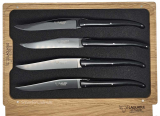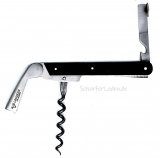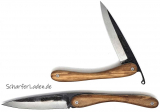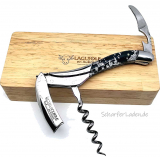LAGUIOLE EN AUBRAC
previous price 25,00 ¤
Now only 22,50 ¤10% 19 % VAT incl. excl. Shipping costs
LAGUIOLE EN AUBRAC
LAGUIOLE EN AUBRAC MESSER SHOP Laguiole pocket knife - a farmer's knife originally for eating cheese and bread . Invented in 1829 in the small village of Aveyrons in the south of France . The back of the knife is beautifully engraved by hand .Traditional French craftsmanship with the finest materials - each knife is assembled by one and the same person.
Knife making in Espalion
Cutlery in Espalion has a long tradition, as there were already two cutlers in the 17th century. Production was geared exclusively to the needs of the canton's population: straight knives, so-called capujadou knives, scissors for marking livestock, bread cutters, mops and winemaking tools, hatchets for forestry. By the end of the 17th century, Espalion had become one of the five clandestine centers for the assembly of cheap locking knives with a nail from St. Etienne, the so-called "jambettes stéphanoises". The assembly was organized by a family of knife masters, the Canels, who came from Le Chambon, a cutlery community near Saint Etienne. These knives were sold in the region by peddlers and at fairs. His son Canel, who was also a cutler, became Bayle of the Brotherhood of Saint Eloi in Espalion. This very old and still active brotherhood united all trades related to blacksmithing and metalwork.
Casimir Moulin, who was the first cutler in Laguiole in 1828, left the Aubrac plateau around 1850 to settle in Saint-Côme d'Olt with his son, who was also a cutler. There they set up their forge and cutlery shop. Moulin made Laguiole knives by hand in his forge and later turned to Thiers to have his knives made there. The Moulin knife forge closed around 1911.
Around 1874, Antoine Auguste Marin Salettes set up as a cutler in Espalion, where he was soon followed by his brother Charles. The Salettes family, which was closely associated with the art of cutlery in Aubrac, was related to the Belmon, Pagès and Calmels families. Auguste Salettes' brother had married the daughter of the cutler Delrieu from Espalion. Salettes forged his blades in his large forge, where he also produced small forged items. The whetstones and polishing wheels were driven by a mechanism powered by dog traction.
Salettes made Laguiole blades by hand until 1930, when his forge was destroyed by fire. Since 1874, he had outsourced part of his production to Thiers, where he sent the templates for the knives he developed. In 1897, he received a silver medal at the international trade fair in Marseille for an exceptional knife that he had produced together with Pagès and Calmels.
Christian Lemasson
Ethnographer.
Translated with DeepL.com (free version)


































